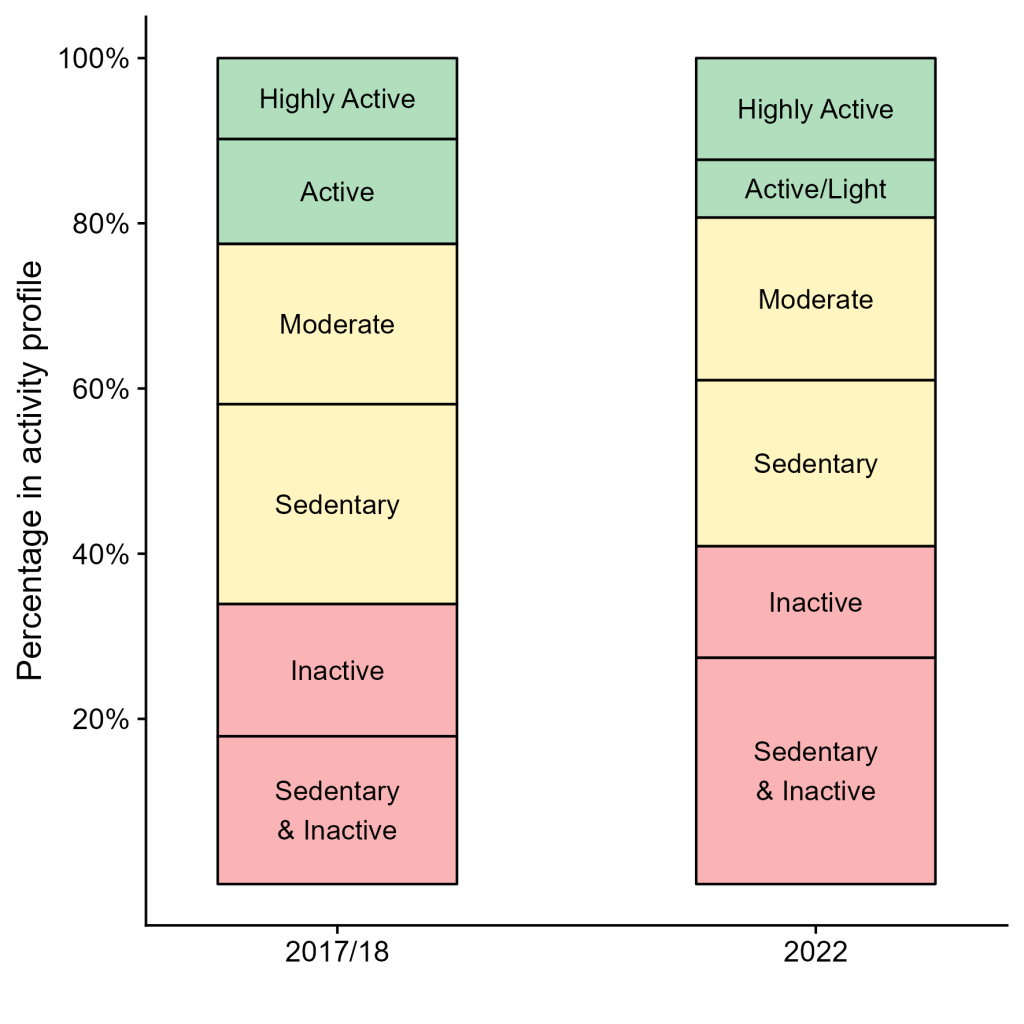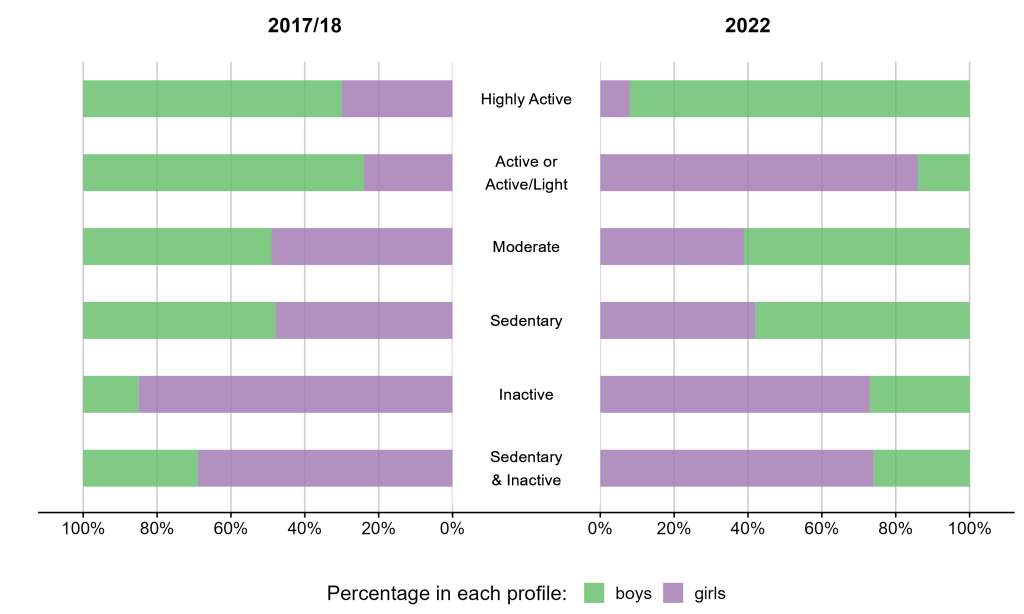Who’s doing what? How patterns of children’s physical activity have changed since the pandemic
- 28 November 2023
This blog was originally published by the Youth Sport Trust on 28 November 2023.
The Active-6 project led by researchers at the University of Bristol’s Centre for Exercise, Nutrition, and Health Sciences and Bristol Medical School and funded by the National Institute for Health and Care Research (NIHR), has been exploring how Year 6’s physical activity has changed since the pandemic. Here Dr Ruth Salway provides an overview of the findings from a paper published today, and what they mean for inequalities in children’s physical activity.
- Over a quarter of the children in the Active-6 study in 2022 are now classed as very sedentary and very inactive, an increase from before the COVID-19 pandemic
- The gender gap has widened, and now only 8% of highly active children in the study were girls, compared to 80% of those classed as very sedentary and very inactive
- Socioeconomic differences have increased, and fewer of the highly active children and more of the inactive children in the study were from households with lower educational qualifications
Activity patterns among children
After COVID-19 restrictions were lifted, we found six activity profiles of children, from most to least active:
- Highly active – children in this profile were very active, especially on weekends, and spent less time being sedentary than average. They nearly always met the UK physical activity guidelines.
- Active/Light – children in this profile were more active and less sedentary than the average child and spent more time in light activity. The majority met UK physical activity guidelines.
- Moderate – children in this profile had average levels of both physical activity and sedentary time, with just over half meeting UK physical activity guidelines.
- Sedentary – children in this profile had average activity levels but also high levels of sedentary time, especially on the weekends. Fewer than half met UK physical activity guidelines.
- Inactive – children in this profile had low levels of activity and average levels of sedentary time. Hardly any met UK physical activity guidelines.
- Sedentary and inactive – children in this profile had very low activity and very high levels of sedentary time, with hardly any meeting UK physical activity guidelines.

Key findings
The image on the right shows how the percentage of children in each of the activity profiles has changed since the pandemic.
In the green profiles, the majority of children meet the UK physical activity guidelines, in the yellow profiles it is about half and half, and in the red profiles the majority of children do not meet the guidelines.
How children are active has changed
- A new profile has emerged – we found a change in the activity profiles before and after the pandemic. Pre-COVID-19, the active profile included children who were more active than average, but had typical levels of sedentary time. Post-COVID-19, this profile disappeared and instead we found an active/light profile, where children were less sedentary and spent more time in light activity. This suggests a group of children engaging in a different mix of activities to before.
- More children in the least active profile – the percentage of children in the least active profile, sedentary and inactive, has increased from a fifth of all children to over a quarter (27%). This means that this very inactive and very sedentary profile is now the most common activity profile, and 41% of children are in activity profiles where the majority of children do not meet UK physical activity guidelines.
- The gender gap has widened – the most active profile has always been dominated by boys, but post-COVID-19 this has increased. There are now even fewer girls in the highly active profile, with the percentage decreasing from 30% to 8%. Meanwhile, we see the opposite pattern among the least active children, with the percentage of girls in the least active profile increasing.
- Socioeconomic differences have increased – we also found a widening socioeconomic gap. The highly active profile included fewer children from households with lower educational qualifications, while the Inactive profile included more. These differences are more pronounced than before the pandemic.

What does this mean for children’s physical activity?
Children’s physical activity has changed post-COVID-19, in terms of who is being active and how (see data on the new normal and data on club participation). While activity levels have returned, on average, to pre-pandemic levels, our study shows a more polarised picture, where more children now tend to be either very active or very sedentary. This is important as it means that more children may be at risk of poorer health and wellbeing because of a sedentary lifestyle.
Above all, this study gives us vital information on the negative impact the pandemic has had on the physical activity of girls and children from lower socioeconomic backgrounds, and the ways their activity behaviours have changed, with existing gaps widening post-pandemic. We need to work hard to tackle these inequalities and support their participation in physical activity.
For more information about research methods, peer-reviewed scientific publications, and other project information, please visit our project website.
The Active-6 project
The Active-6 project investigated whether the COVID-19 lockdowns had a lasting impact on children’s activity. To do this, we compared accelerometer-measured activity levels of Year 6 children in primary schools in the greater Bristol area before the pandemic in 2017/18 and after in 2022.
The UK Chief Medical Officer recommends that children should do activity that raises the heart rate, makes the breath faster, and body feel warmer for an average of at least an hour per day. This is called moderate to vigorous physical activity.
Active-6 research has shown that, on average, children’s activity had returned to pre-pandemic levels by 2022, although they spent more time being sedentary than before. And worryingly, still only 41% of children met these guidelines.
But just looking at averages can hide a more complicated picture. We wanted to find typical patterns of physical activity and sedentary time that tend to occur together. These ‘activity profiles’ can be used to identify common groups of children, especially those least likely to be active and so at risk of poorer health and wellbeing. We looked at how these profiles had changed post-lockdown, and whether there were gender or socioeconomic differences.
